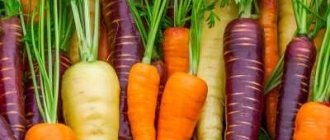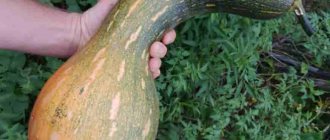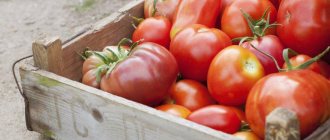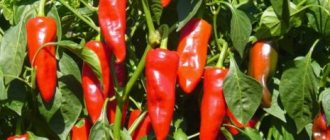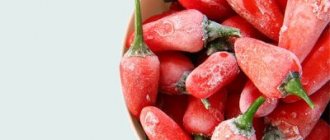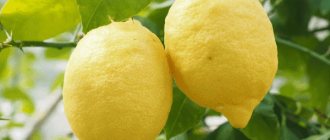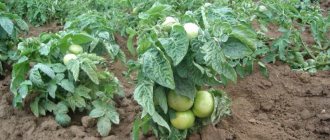The shelf life of a tomato harvest depends on many factors - proper care throughout the season, timely and correct harvesting of fruits, as well as the creation of optimal storage conditions. An important role is played by the choice of variety. It is no secret that some tomatoes can be stored for only a few weeks, while others can retain their taste and commercial qualities until spring.
Breeders are working hard to develop tomato varieties that can maintain freshness, elasticity and rich taste for more than six months. For long-term storage, it is better to choose shelf-stable (up to 5-6 months) and long-lasting varieties (up to 6-8 months).
"Giraffe"
One of the very first varieties for long-term storage. The bush is tall, up to 2 meters in height. In warm regions it can be grown outdoors, but in cooler locations it is better suited to a greenhouse.
The fruits are yellow-orange with thick skin. Up to 5 kg are collected from the bush.
The specificity of the variety is that its tomatoes on the branch never ripen. They are harvested while still green, when they have reached their full weight (for their variety). This stage is called technical ripeness. After a month of storage, the tomatoes can be eaten. Stored until the end of February - beginning of March.
Tomatoes-champions for keeping quality: the longest-lasting varieties and hybrids
We included the very best in this group. They fill slowly, ripen for a long time and reach maturity not on the bush, but much later - by December. As a rule, such varieties do not have a bright color; they are yellowish or light orange with pink flesh. Their taste is incomparable with summer varieties, that’s clear. But opinions about the taste are so different that until you try it yourself, you won’t know.
Tomato varieties for long-term winter storage
Long Keeper
Late-ripening (125-135 days), high-yielding, unpretentious variety. Determinate plant up to 160 centimeters high. Does not require mandatory pinching, usually formed in 1-2 stems.
The fruits are round and flat-rounded, medium in size (up to 200 grams). The skin is smooth, thick, the flesh is dense, reddish-pink in color. A fully ripened fruit acquires a light orange color on the outside, but these tomatoes rarely ripen on the bush. For storage, they are removed at the stage of technical ripeness, when the tomatoes become milky white. The fruits are well transported and stored until February-March.
The variety is resistant to fusarium, tobacco mosaic, and cladosporiosis.
New Year
Late ripening variety - from germination to technical ripeness 120-140 days. The plant is indeterminate, so it will require pinching and tying to a support. It is recommended to form it into 1 stem.
The fruits are medium (130-200 grams) flat-round in shape. The skin is dense, shiny, and does not crack. When fully ripe, the fruit is yellow-orange on the outside and pink on the inside. The pulp is dense and juicy. For long-term storage, the fruits are picked light green and ripened indoors. Tomatoes store well for 3-5 months after picking.
The variety does not require special growing conditions and is resistant to cladosporiosis, fusarium, and tobacco mosaic virus.
Long lasting
Late (120-125 days) productive semi-determinate variety. The plant is strong and tall, over one and a half meters, that is, it cannot be done without pinching and garter. Formed into one stem.
The fruits are round, slightly ribbed, average weight - from 90 to 150 grams. Ripe tomatoes are yellow-orange with a dense, smooth skin and red-orange flesh. Like all other tomatoes for winter storage, they are recommended to be collected unripe. The fruits are perfectly preserved fresh for up to 6 months, even at temperatures of 15-19C.
The variety is unpretentious and resistant to major tomato diseases.
Giraffe
Late-ripening, productive indeterminate variety. The plant is tall and grows all the way, so it requires staking and pinching and, as a rule, is grown in one stem.
The fruits are round, small in size and weight (from 60 to 130 grams). Ripe tomatoes become yellow-orange with smooth, dense skin, although they are removed from the bush unripe for storage. The pulp is quite dense, dry with a small amount of seeds, orange-pink in color.
The variety has excellent transportability and shelf life up to 6 months. Resistant to unfavorable environmental conditions, has immunity to tobacco mosaic virus, brown rot and brown spot.
Dey Huanchi
Medium late (100-120 days from germination to fruiting) Chinese variety. The plant of the determinate type reaches a height of only 45-50 centimeters, which means there is no need to shoot and form a bush.
The fruits are round, very dense, fleshy, weighing 150-200 grams. Ripe tomatoes turn orange both outside and inside. They are not subject to mechanical damage, are well transported and last until the end of December.
The variety is valued for its special vitality, grows in any conditions, and is suitable for open ground.
Lezhky
Late-ripening (from germination to ripening 115-120 days) determinate variety. The bush grows up to a meter in height. You will need a garter, pinching and formation into three stems.
The fruits are orange in color and flat-round in shape. The average weight of a tomato is 100-120 grams. The skin is dense and does not crack. For long-term storage, the fruits are picked in August-September while still green. They last well until February, maybe longer.
The variety is resistant to major tomato diseases and produces high yields.
Winter heart
Late-ripening determinate variety. The plant reaches 70 centimeters and requires staking to a support. Fruits abundantly.
The fruits are large (250-300 grams), round or slightly heart-shaped with slight ribbing at the stalk. When ripe, it is light yellow or yellowish-green in color. The tomatoes are fleshy with a small amount of seeds, dense, with thick skin and do not fall off the bush for a long time. Stored for up to 6 months.
The variety is considered very tasty for long-storing tomatoes.
Japanese truffle
Medium-late (110 - 120 days from full germination to ripening) indeterminate variety. The bushes grow up to 1.8 meters. They need to be tied and formed (can be 2 or even 3 stems).
The fruits are pear-shaped with longitudinal ribbing over the entire surface. Average weight - 100-150 grams. Tomatoes with shiny skin and fleshy, rather dense pulp. If there is high humidity, they may burst at the stem. They come in red, yellow, orange and black. Yellow and orange are considered the most durable.
The fruits ripen well during storage. In good conditions they can survive until the New Year.
The variety is highly resistant to major viral and fungal diseases of tomato.
Hybrids (F1) of tomatoes with a long shelf life of fruits
Cartouche F1
Hybrid of average ripening period, from germination to fruiting 110-115 days. The plant is medium-sized, semi-determinate type. The bush reaches a height of 1.5-1.7 meters. It is recommended to form it into one stem, moving the growth point to the lateral stepson.
The fruits are flat-round, weighing 140-160 grams, intense red color without a green spot at the stalk. Tomatoes are very dense, so they can be stored without loss at room temperature for up to 3 months.
The hybrid is resistant to pathogens of tobacco mosaic virus, cladosporiosis, and fusarium.
Decembrist F1
Medium-late (110-125 days) semi-determinate hybrid. The bushes grow up to 90-100 centimeters and need staking, pinching and shaping. It is best to form a plant into 2-3 stems by transferring the growth point to the side shoots.
The fruits are large (up to 300 grams), flat-round, dense, red at maturity. They ripen slowly, so most often they are picked unripe and stored for storage and ripening. Tomatoes last up to 6 months.
The hybrid is resistant to tobacco mosaic virus, cladosporiosis, fusarium, and root-knot nematodes. Tolerant to late blight.
Zazimok F1
Mid-season, high-yielding semi-determinate hybrid. It takes 100-110 days from full germination to ripening. Plants reach a height of 0.9-1 meters; they require staking and pinching. They are usually formed into two stems, leaving a stepson with a new growth point after the third inflorescence from the bottom.
The fruits are round, dense, weighing up to 200 grams. Ripe tomatoes are red in color and have a very good taste for long-lasting tomatoes. If storage conditions are met, they can last until December.
The hybrid is tolerant to late blight and is also resistant to cladosporiosis, fusarium and tobacco mosaic virus.
Christmas Eve F1
Semi-determinate mid-late hybrid. The ripening period is 110-120 days. The bushes are well leafy, tall - from 90 to 150 centimeters. Plants need tying, pinching and shaping. Form into 1-2 stems.
The fruits are round, thick-skinned and very dense. Average weight - 120-130 grams. At the stage of ripeness they turn red, but usually the color and real taste only gain by December when stored in a cool room.
Like previous hybrids from, this tomato is resistant to tobacco mosaic virus, cladosporiosis, fusarium and root-knot nematodes. Tolerant to late blight.
Lounger F1
Mid-season (107-110 days from germination to fruiting) high-yielding hybrid of determinant type. The bush grows to a height of 1.3 meters. To increase productivity, it is formed into 2-3 stems.
The fruits are flat-round, red with dense, smooth skin. Not prone to cracking. Average weight - 100-160 grams. The pulp is quite dense, red, fleshy. For long-term storage, tomatoes are picked while they are still green, then they keep well until December without losing their taste and appearance.
The hybrid is unpretentious in cultivation, resistant to tobacco mosaic virus, cladosporiosis and fusarium.
Snowfall F1
Late-ripening indeterminate hybrid. The fruit ripening period is 120-150 days from germination. The plant is tall (from 1.2 to 2 meters), branched, requires pinching and staking. It is recommended to form into two stems.
The fruits are round, slightly ribbed towards the stalk, red in color, weighing from 100 to 130 grams. The peel is smooth, glossy, dense, does not crack, the flesh is dense, red, with a pleasant sweet taste. When ripe, tomatoes are stored at room temperature for 2 months, and when picked green in the fall, they will last well until the New Year.
The hybrid tolerates low temperatures well, is resistant to the tobacco mosaic virus, but can be slightly affected by anthracnose and alternaria.
Metelitsa F1
Mid-season (100-110 days) hybrid of determinant type. The plants are short, compact, from 60 to 100 centimeters, but it is better to cut off the stepsons before the first flower cluster. Then form a bush into two stems.
The fruits are round with slight ribbing, weighing 60-100 grams. Red in color at full maturity. The skin is dense, glossy, does not crack, and retains its shape when canned. The pulp is fleshy, reddish, the taste is sweet and sour. Tomatoes are well transported and do not lose their presentation. When storing light green fruits, they reach ripeness by December.
This tomato is resistant to tobacco mosaic virus, cladosporiosis, fusarium and root-knot nematodes. Tolerant to late blight.
Empire F1
A mid-early, high-yielding indeterminate hybrid, 95-100 days pass from germination to fruiting. The plant is tall, up to 2.5 meters. A garter is required and the stepsons are removed to form a bush with two stems.
The fruits are plum-shaped with a small spout, red-orange in color. The skin is smooth, dense, and does not crack during heat treatment. The average fruit weight is 90-140 grams. Ripe fruits last well at home for up to 1.5 months without loss.
The hybrid is resistant to tobacco mosaic virus and vertricillosis. Tolerant to cladosporiosis.
"Long Keeper"
The plant ripens well in an open place or protected with film. The height of the stem is up to 1.8 meters, the yield is about 4 kg of tomatoes per plant.
The fruits themselves are yellow-pink when ripe, and when cut open they are dark pink or scarlet. Tomatoes have a hard skin, and the flesh is a little dry and dense.
Tomatoes are picked green, at the stage of milky ripeness, ripening occurs in 30–40 days. If stored properly, they will last until the end of April.
Cherry tomatoes with a long shelf life
Small cherry tomatoes are also characterized by increased shelf life compared to large fruits. That’s why they deserve a place on our list of the longest-lasting tomatoes. Moreover, some varieties are real champions of long-term storage.
Stone flower F1
Determinate dwarf hybrid of early ripening - 70-85 days pass from germination to the appearance of tomatoes. The plants are standard, low-growing, only 35-40 centimeters in height, so they can be grown even on the balcony. There is no need to trim or tie up the bushes.
The fruits are round, rich red in color with a strong skin that does not burst. Average weight 10-12 grams. The pulp is very fleshy and juicy, dense, with a small amount of seeds. The taste is excellent, sweet without sourness. Ripe tomatoes do not fall off the bush and are easily transported and stored.
The hybrid amazes with its productivity. In addition, it is resistant to many tomato diseases: tobacco mosaic virus, verticillium, root and basal rot.
Honey drop
Mid-season indeterminate variety with a ripening period of 110-115 days. The bushes are tall, up to 2.5 meters with a large number of stepsons. A garter to a support and formation is necessary (can be planted in 2-3 stems).
The fruits are drop-shaped, bright yellow when ripe, weighing 20-30 grams. They behave well in conservation. They taste very sweet. If you collect them unripe at the end of the season, they can last until the New Year.
The variety is resistant to major tomato diseases.
Cherry Kokta F1
High-yielding early hybrid of indeterminate type. Fruiting occurs 95-100 days after germination. The plant is tall and requires staking and shaping into 2-3 stems.
The fruits are red, round in shape, weighing 50-65 grams. The skin is thin, the flesh is juicy, aromatic, sweet with sourness. The fruits are transported well, do not wrinkle or crack. And they are stored for a long time.
The hybrid is resistant to fusarium, verticillium, tomato mosaic virus, and tolerant to gray rot.
Golden Rain
Late (125-135 days) productive variety of cherry tomatoes. Tall indeterminate bush - up to 1.8 meters. It is impossible to do without strong support and formation, however, it is permissible to form it into three, even four stems.
The fruits are light yellow, elongated, weighing 25-40 grams. The pulp is fleshy and juicy. The taste is sweet with a slight sourness. The keeping quality and transportability of the fruit are excellent.
The variety is resistant to tomato diseases such as tobacco mosaic, Alternaria blight and cladosporiosis. In a greenhouse it shows higher yields than in open ground.
"Ozaltin"
Tall variety for open air and greenhouses. The bush stretches up to 2 meters; during the fruiting period the branches need support.
Why Queen Anna potatoes are so popular: description of the variety, pros and cons
Tomatoes ripen late (at 130–140 days). When ripe, they become bright scarlet, with a regular round shape, weighing from 60 grams. You can collect up to 5 kg from one plant.
The pulp is sweet, dense, aromatic. “Ozaltin” is considered the most delicious of tomatoes that are kept fresh all winter.
If you want to save the fruits for 6–8 months, they are picked half-green. Ideally, they will last until spring.
Rules for storing fresh crops
Harvested and sorted tomato crops with a long shelf life are provided with conditions under which ripening occurs for as long as possible. To do this, they are placed in a cool place away from apples, bananas and other fruits that emit ethylene. The presence or absence of lighting does not play a significant role. At home, you can store green tomatoes on a shelf in the refrigerator, in the cellar or in glass jars. Each option has its own subtleties.
In a refrigerator
A small number of tomatoes can be placed in the vegetable compartment of the refrigerator for ripening. It is convenient to store the harvest of cocktail varieties or cherry tomatoes. Before planting, it is advisable to wipe each tomato with a napkin and turn the cuttings up. Every day you should ventilate the shelf with tomatoes and sort out brown or reddened specimens. They release ethylene, which speeds up ripening. You can isolate the fruits from each other using individual paper packaging. Fully ripened tomatoes will retain their quality for no more than a week.
On a note! It is not recommended to store vegetables in a plastic bag. In this form, oxygen access is difficult and conditions are created for high humidity, which provokes rotting.
In the cellar or basement
The optimal solution for preserving the harvest is a cool cellar. The room temperature should be 8-15 °C. The higher it is, the sooner the tomatoes ripen. The collected tomatoes are laid out in wooden boxes in several layers (optimally 2-3). To avoid condensation accumulation, lay them out in layers of paper, newspapers or sawdust.
An important storage condition is periodic ventilation. This procedure is combined with a harvest audit. Ripe tomatoes, which begin to change color earlier than others, are transferred to a separate container. Remove specimens with signs of rotting or other damage. In a basement or cellar, the harvest can be stored for several months, depending on the variety.
"Gift of Autumn"
A low-growing standard bush that grows best in a greenhouse. The fruits ripen late (September-October). Unripe ones have a “marbled” red-orange color, and the riper the tomato, the more orange it becomes. Harvest - up to 7 kg per bush.
The tomato is juicy, with a fairly large weight - 250–300 g. They are removed pale green or brown. They don't go bad until March.
Tomato "Winter Mallorcan"
Tomato "Winter Mallorcan" (Mallorca de cogar, Ramillette) originates from the island of Mallorca (Spain). To extend the shelf life of these tomatoes, local residents string them on a rope in the form of a small bunch. Stringing tomatoes in this way has been a Mallorcan tradition for over 100 years, as it has been passed down from generation to generation. These tomatoes are one of the most important ingredients in Mallorcan cuisine.
This is a determinate variety with a height of 50-70 centimeters. Productivity is high. Forms powerful bushes strewn with medium-sized tomatoes (150 grams). Tomatoes are light colored (pink) with small yellow markings. During storage, tomatoes do not wrinkle because they do not lose moisture, so they can be stored at room temperature for six months or more. “Winter Mallorcan” has a classic tomato taste, but it lacks the sweetness characteristic of many varieties. Tomato is resistant to many diseases and adverse weather conditions.
"Rio Grande"
Determinate plant, up to 1 meter high. This is an old Dutch variety, originally created only for greenhouses. But today it is one of the most popular tomatoes in the world, growing both in open ground and in shelters. "Rio Grande" produces excellent yields (up to 8 kg per bush).
The fruit is a classic fleshy cream with a thick skin. The taste is bright and sour. To keep tomatoes for several months, they are harvested before frost, choosing fruits with a faint pink color (blanc ripeness). Stored until January-February.
Tomato "Jaju"
The Giagiù tomato is the yellow form of the classic tomato variety grown at the foot of Mount Vesuvius in Italy. "Piennolo del Vesuvio" itself is a very old Italian variety of tomatoes. Its history dates back to 1858, and according to some sources, this tomato was known even earlier.
Its fruits are bright red, plum-shaped, with a characteristic pointed nose. Often the fruits also taper slightly near the stalk. The taste is sweet and sour with an intense typical tomato aroma. Due to their small size, these tomatoes can be classified as cherry tomatoes.
The main feature and advantage of the variety is that the fruits do not fall off even after full ripening, have relatively thick skin, dense pulp, and a high content of sugars and acids. Such features allow you to store the collected fruits for a very long time.
Italian farmers cut the entire bunch when about 70% of the fruits are ripe (the last fruits begin to turn brown). Then the bunches are tied with twine into large bunches (about 2-3 kilograms) and hung in protected from the cold, but ventilated areas, where they slowly ripen. In this form, tomatoes can remain fresh for up to 7-8 months. As they are stored, their taste develops, becoming more complex and refined.
Until spring, Piennolo del Vesuvio tomatoes are eaten fresh in salads, and are also used in many sauces, seafood dishes, pasta, pizza, etc. These tomatoes are considered a local delicacy and are sold at a fairly high price in the markets and shops of Naples and Pompeii. They can be seen hanging on market stalls, pizzerias and restaurant kitchens. For local vegetable growers, growing such tomatoes has become a profitable business.
The yellow-fruited variation of this variety, called “Jaju,” also has its own history. According to legend, it got its name from the name of the Corsican girl Jaju, who, while harvesting red Piennolo del Vesuvio tomatoes on a plantation near the foot of Mount Vesuvius, discovered yellow fruits. The girl brought an unusual find to her parents and they collected seeds from this wonder.
Since that time, the yellow-fruited Piennolo del Vesuvio variety has been grown alongside the classic red variety. The varieties do not differ from each other in terms of growth type, ripening time, size and shape of fruits, characteristics and storage period. Their only difference is the color of the fruit.
Tomato “Giagiù”, Yellow Piennolo del Vesuvio. © Lyudmila Svetlitskaya
Dried Jaju tomato tastes better than fresh one. © Lyudmila Svetlitskaya
My review of the tomato variety “Dzhaju”
Seed sellers note that the unique characteristics of the Piennolo del Vesuvio and Jaju tomatoes are the result not only of the genetic properties of the variety, but also of the specific growing conditions on mineral-rich volcanic soils in a warm Mediterranean climate. However, the tomatoes that grew in my garden fully corresponded to the characteristics described above.
In appearance, they were very beautiful, teardrop-shaped with spouts, bright yellow in color, collected in small clusters of 5-10 pieces. Another feature of tomatoes that I observed both in my beds and in my mother-in-law’s garden is curled leaves on all the bushes. At first I thought that the plant was missing some nutrients. But in one of the descriptions of such tomatoes on the Internet, I discovered that such twisted foliage is a varietal feature. The bushes turned out to be about a meter high and needed staking.
As for the main question - how these tomatoes were stored during the winter, then everything was a little ambiguous. The first two or three months after harvest, the tomatoes were stored perfectly, without losing their shape, their taste could be called quite pleasant, although, of course, they were inferior to summer tomato varieties.
But later the ripest ones began to wrinkle. Remembering that these tomatoes are also used as sun-dried tomatoes in Italy, we dared to taste these wrinkled tomatoes. And imagine our surprise when it turned out that the sun-dried tomatoes were much sweeter and tastier than those that looked firmer and fresher!
Looking ahead, I will note that the “Jaju” variety of tomatoes turned out to be the most delicious of all the varieties of winter tomatoes I tried and the most similar to summer tomatoes. But, of course, we had to get used to the sight of sun-dried tomatoes. Therefore, they were used mainly in various dishes - baked in pizza and with other vegetables. But in a salad, Jaju tomatoes still, in my opinion, don’t look very attractive.
At the beginning of March, all the tomatoes had already become wrinkled to varying degrees, but were still edible; some of the fruits had spoiled during storage and had to be thrown away, but 70% of the fruits were well preserved.
The Jaju tomato has curled leaves. © Lyudmila Svetlitskaya
"Winter Heart"
Low-growing variety with late ripening. The plant is heat-loving, so a good harvest (4–5 kg) can only be obtained in a greenhouse.
Large-fruited peppers: 5 varieties worth paying attention to
Tomatoes are heart-shaped, light yellow in color, weight up to 200–400 g. The pulp is fleshy, with a delicate taste.
Ripening begins in September. If you pick tomatoes unripe, they will be edible until late spring.
French madness, or spring aggravation. Part 1, nightshade
We will talk about seeds, because the main symptom of a spring exacerbation at 7 dachas is the purchase of seeds!
Unlimited by anything, because all the brakes failed at the first spring sun, along with the last reason :). So, following one of the links helpfully provided by Ganna, it was quite by chance that a delivery was discovered to me, almost to Lapland... And then Ostap suffered!!! Well, can I, can I brag?!!! Here the puppy should jump and whine, faithfully looking into the eyes and licking everything around. It must be said that the French do not chase new products not only from domestic, but also from global selection. Their specialty is old, proven and carefully preserved varieties and curiosities. This is why hybrids are quite rare on their sites
I'll start with the peppers, there are only 4 of them
1. Alma Paprika is a very beautiful variety of semi-hot pepper, something from the Gogoshar family. The fruits are white, then red, 5 cm in diameter, weighing from 80 to 120 g, not very strong, crispy, with thick pulp of delicious taste, also called “hot apple”. A spice is made from it - paprika powder. Hungarian variety. I want to find the perfect marinade!
Alma paprika
2. Yellow Ox Horn Pepper Corno di Toro Giallo” is a yellow version of the “Corno di Toro Rosso” (red ox horn). An old variety from Italy, it produces juicy, horn-shaped fruits, 18-20 cm long, green in color, turning yellow when ripe. Sweet and aromatic taste. Good performance. Early variety. Let's check for sweetness!
Here they are, the horns, there is also a red one, but I haven’t bought it yet...
3. Marconi Rosso , about 20 cm long, is an old variety from Italy that produces large and long, slightly deformed fruits of a beautiful red color, sweet and aromatic taste.
4. Teos - giant fruits 24 cm long and 12 cm wide, dark green, turning golden yellow when ripe, weighing up to 550 grams. LAMUYO type (just in time for my red Lamuyoshki!), tender and sweet pulp, good disease resistance, for garden crops and under cover. It’s just a pity that it’s a hybrid, but if we try it, we’ll buy it!
Marconi and lamuyoshki, mmm...
What can you not find in the open spaces...
Shall we laugh?
And a little more eggplant ... however, I wouldn’t call THIS eggplant anymore. :))) Due to the fact that these are some vegetables from the eggplant family, and therefore they were affectionately called African and Thai, well, so as not to come up with a name for a new vegetable. You have to try everything!
1. Jiló Comprido Verde Claro - African eggplant Comprido Verde Claro (or Jiló Comprido Verde Claro) is a very productive variety native to Brazil. The fruits are about 5 cm long, elongated, light green in color. Very characteristic tart taste. The plant is suitable for growing in pots. Especially for the grill!
2. Louisiana Long Green is an unusual variety that produces long green fruits with very fine stripes. Each fruit is 25 to 30 cm long. The tasty white flesh is much softer than the classic eggplant with a small number of seeds.
3. Kermit - the original Thai variety. Eggplants have a diameter of 5 cm (40-60 grams), they are round, green in color, with white veins. Young fruits are very tasty and can be eaten fresh or boiled. The plant is suitable for growing in pots. Labeled as a hybrid.
Eggplant?
Well, now TOMATOES ! I'll start with the uninteresting, they gave me a package of black Tula tomato and Black Prince as a gift. These are well-known, old, classic Russian varieties, which I already have, thanks to Lera for this :)))) However, you must agree, it’s nice to read: Black Prince is a red-brown mid-season tomato variety originating from Siberia, which tolerates very well cool climate. Gives a good harvest with medium-sized fruits (100-150 g), round or sometimes slightly elongated, juicy. One of the sweetest varieties of tomatoes. Ideal for salads. Black from Tula is a red-brown to black tomato variety with greenish shoulders. Originally from Ukraine, it produces a good harvest with fruits of medium size, rather flattened, very fleshy, with a rich and sweet taste. Ideal for salads! But here the guys got confused with geography. Tula has never been Ukrainian :))))
And then it gets interesting!
1. White Beauty is an heirloom variety that produces cream-colored fruit with a mild, sweet, and juicy flavor (the fruit has a high sugar content). Ideal for making beautiful, colorful tomato salads. This is an old tomato variety originating from the USA and created in 1860.
2. Oxheart Orange - is an old variety that produces heart-shaped fruits with firm, aromatic and tasty orange pulp containing few seeds. Soft and sweet taste. Large-caliber fruits (from 250 to 500 grams). A very productive variety. The origin was not written here. But handsome!
3. Madagascar is a cocktail tomato that produces clusters of 5-8 round fruits of 30-50 g, with a beautiful two-color skin from light pink to yellow. Hard, soft, sweet, with a pleasant aroma. Excellent preservation tomato. Madagascar tomato , as the name suggests, is a tomato originating from Madagascar. It has the ability to be stored for a very long time indoors at room temperature.
Various beautiful tomatoes
4. Shaggy green zebra ! As soon as the zebras were not mocked, now it is also shaggy :))) It produces fruits weighing 70-90 grams with green fluffy skin with yellow veins. The green-blue foliage, which is also fluffy, gives this variety all its originality. Nothing about the origin...
5. Moldavian green is a tomato variety that produces large fruits from 200 to 400 grams, slightly flattened, green-amber in color. Dense pulp with a very mild taste. Originally from Moldova.
Various beautiful tomatoes
6. Blue Pitts, or Blue Pitts , are my first blue tomato cherry tomato. The fruits are small, about 3-4 cm in diameter, of very good taste. During ripening, the color changes from mauve to deep purple and dark red. Moreover, they promise a height of 1.1 meters.
7. Indigo Blue Beauty is a "big tomato" version of the famous Indigo Rose tomato , which is very dark in color in areas exposed to direct sunlight. The fruits are original, flattened, pink, with a very large purple-violet collar, weighing 100-200 g, which becomes red-violet when ripe. Good resistance to cracking and disease.
The Indigo Blue Beauty tomato is a variety originating from the USA and created after many years of research since 1960. It is part of the Indigo Tomato Series: Indigo Apple Tomatoes, Indigo Blue Beauty Tomatoes, Indigo Blue Berry Tomatoes, Indigo Kumquat Tomatoes and Indigo Rose Tomatoes.
This is a blue tomato that contains high amounts of anthocyanins, a blue-tinged antioxidant that improves cognitive function by reducing inflammation and cellular oxidation.
Different tomatoes, beautiful
Well, red heels:
8. Prince Borghese - Principe Borghese is an old Italian cherry tomato variety that produces many clusters of slightly elongated small fruits (50 to 80 g) ending in a small dot. Very dense fruits with a small amount of juice and a few seeds. A vigorous and very productive variety, ideal for making sun-dried tomatoes.
9. Red Sparrow Currant , also called Petit moineau , is a vigorous and very productive creeping variety that produces small, bright red fruits about the size of blueberries. The grains are hard and have a pungent taste. The variety is very resistant to powdery mildew.
Last season my Yellow Currant grew beautifully, without care, shelter, greenhouse or other tambourines, it grew independently and very productively! I want a red pair! The children, and I myself, have a great time grazing around this bush. Moreover, 1 bush is quite enough! And decorate something, and eat! The height of this miracle was up to 1.5 meters.
Various beautiful tomatoes
10. Andean horn, or Cornue des Andes, is a hardy, high-yielding variety that produces many medium-sized, oblong, pepper-shaped fruits (60-150 g). Tomatoes contain few seeds and are ideal for making concentrates, sauces, soups, juices and salads! This is a variety of heirloom tomato brought several years ago from the Andean Cordillera by a French collector.
11. Mikado Violettor (also spelled Mikado Violettor tomato ) is a hardy, vigorous "beef flesh" variety with potato foliage. Medium-sized tomatoes (80-150 g), slightly ribbed, pink in color. Great taste. Well suited for hot regions. Of course, I found the hottest one, but there is hope! Mikado Violet is an heirloom tomato variety originating from Australia, created in 1855.
12. Voyage is a miracle for the eyes, a curiosity of nature... This is a productive variety, with a bushy habit (without pruning), a very original shape of the fruit (tomatoes with several blades), which can reach 100 grams. The flesh is firm, thick and juicy. They don’t write where this Voyage came from. But I heard something about Mexico...
Various beautiful tomatoes
And to finish, as a purely bonus, I’ll throw in a couple of onions for taste! After all, you can’t just go and not buy something delicious! And they promise something very tasty
1. Shallot Zebruin, or Poitou Chicken Legs - large oblong pinkish bulbs (2-5 cm in diameter, 15-18 cm in length), pointed, slightly curved. The flesh is pink, aromatic and juicy.
The French divide onions into 3 groups according to the color of the bulb:
- white onions, early vegetables eaten, such as in vegetable pots or pickled
- yellow onions, for preservation, often eaten cooked
- red onion, mostly eaten raw in salads
Zebrune red belong to the red onion family. This is a French variety originating from Poitou. BUT! This is the French version of the story. There is an even more interesting version, which says that this bow came to France from Germany at the beginning of the Second World War. The onion caught on so well and the French liked it so much that they renamed it from the German Zebruyn to the French Chicken Legs Poitou, where the Germans brought this bow. Full version here.
2. Long red from Florence, or Florentine onion - a variety with an elongated bulb, soft dark red color. The flesh is white, soft and sweet , reminiscent of shallots in taste. Very good preservation, ideal for salads and raw vegetables. For fresh consumption.
The onions are tasty and healthy. And this is what the bags the French sent look like. They are economical, environmentally friendly, and save on shipping. Gannochka, thank you SO MUCH for your help in purchasing and for the tips on goodies! Let's grow! We will try!!!
"Masterpiece 1"
A late hybrid, tall (indeterminate), it is usually grown in greenhouses. Although the tomato has a powerful stem, it needs to be tied up. “Masterpiece 1” yields up to 5–6 kg per bush. Large fruits (up to 500 grams) have a round, slightly flattened shape and are red in color.
For storage, tomatoes are harvested pale green, in September-October. They keep well until mid-spring.
There are many varieties with good keeping quality, and new varieties appear every year. Almost any gardener-farmer can find suitable tomatoes for long-term storage.
Shelf life of tomatoes: how to extend it?
To maximize the shelf life of tomatoes, it is not enough to plant the right variety. It is necessary to provide the crop with competent agricultural technology and properly harvest the crop.
Experienced gardeners recommend following a few tricks that will help preserve tomatoes for a long time:
- In the spring, carry out preventive treatment of seeds, and later - seedlings with fungicides to increase resistance to diseases and pests. Repeat treatment during the season.
— Tomatoes should be stored only if they do not contain pathogenic bacteria and microorganisms.
— The harvest for ripening should be at the stage of milky ripeness, when the fruits have already formed, but have NOT begun to turn brown.
— Fruits picked from healthy bushes can be placed in boxes without any damage. Instances even with minor scratches or stains will quickly rot and neighboring fruits will begin to deteriorate. Specimens damaged by diseases or pests should not be selected for storage. If necessary, they are placed separately from the others.
— You should not remove the stalk if it is firmly held, otherwise you may injure the fruit. Tomatoes are cut with clean, sharp scissors or pruning shears along with the stalk to reduce the cut surface into which the pathogen can enter.
— It is best to harvest tomatoes in dry weather, until the night temperature drops below 5-8 °C. There should be no drops of rain or dew on the fruits, and they should not be heated in the sun.
— Tomatoes collected after overnight frosts are also not suitable for long-term storage, even if they show no signs of damage. — Harvested and sorted tomato crops with a long shelf life are provided with conditions under which ripening occurs for as long as possible. To do this, they are placed in a cool place away from apples, bananas and other fruits that emit ethylene. The presence or absence of lighting does not play a significant role.
